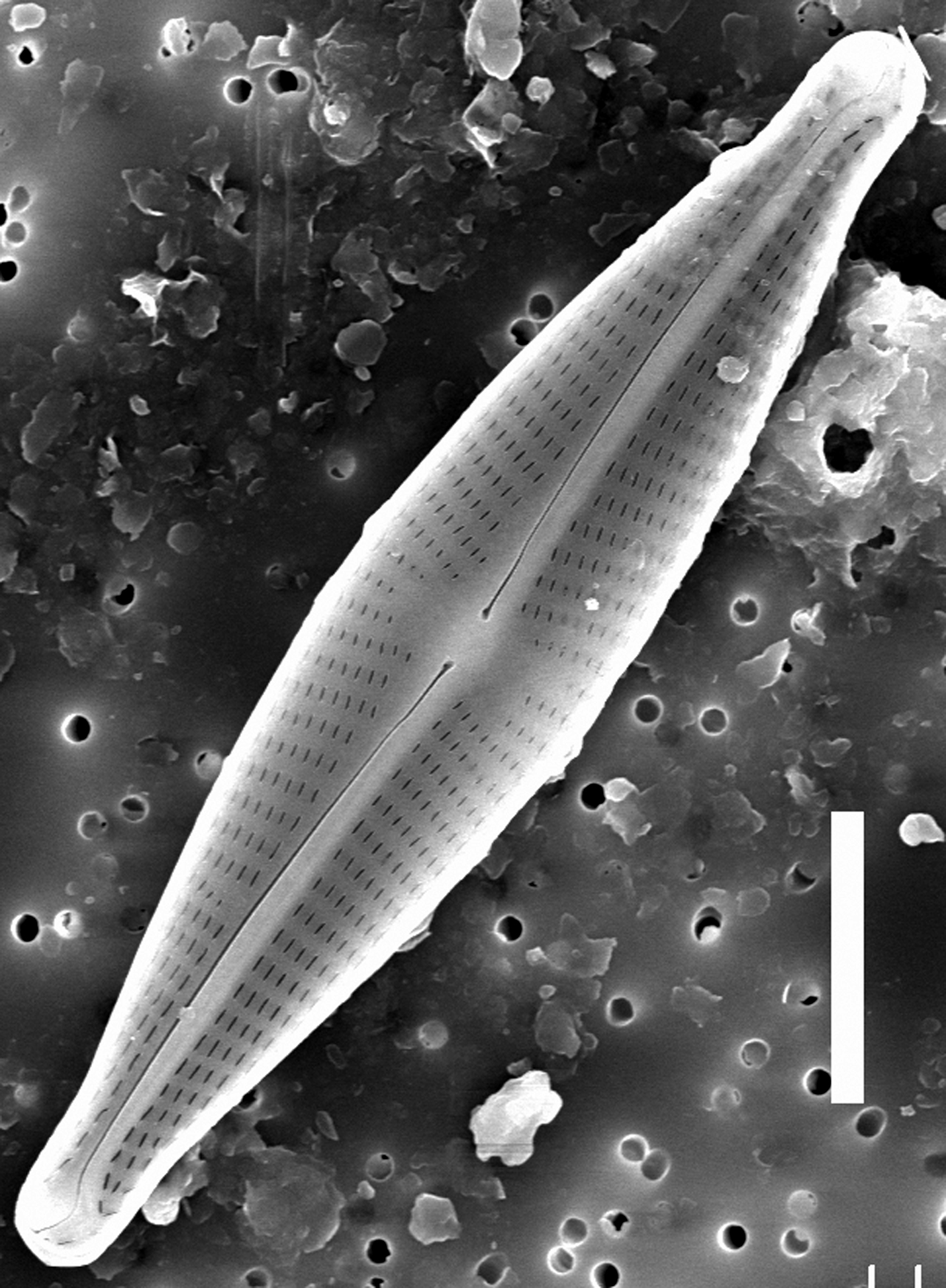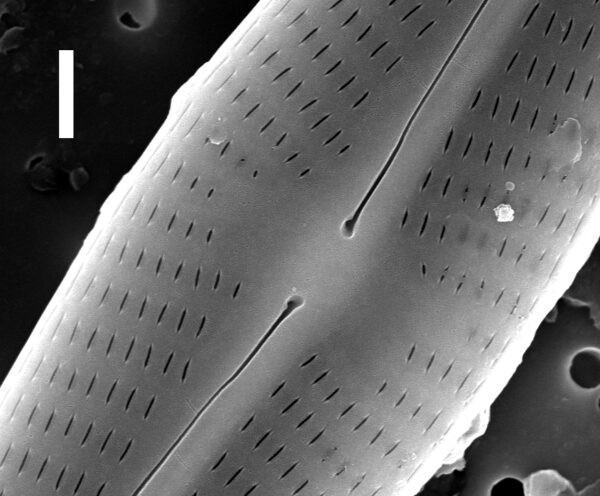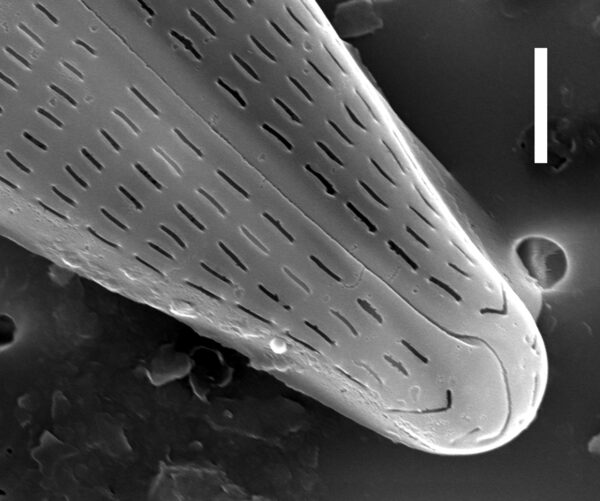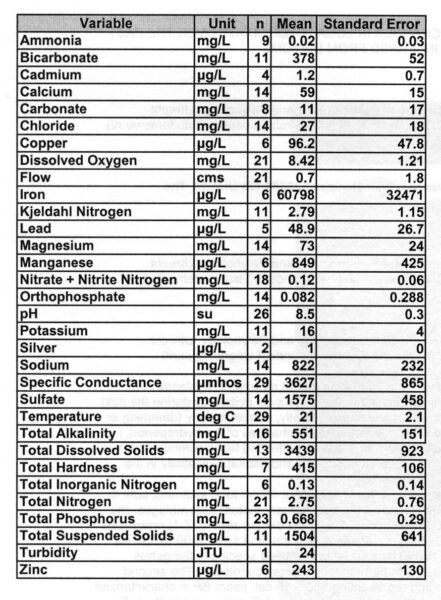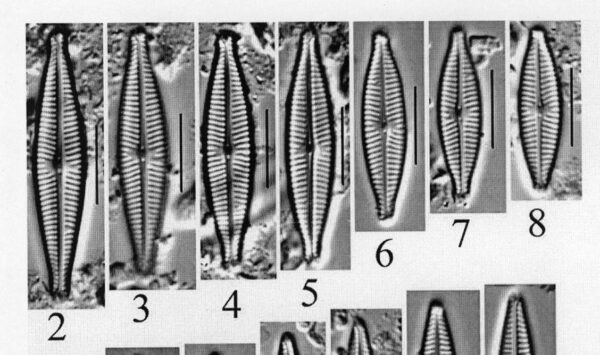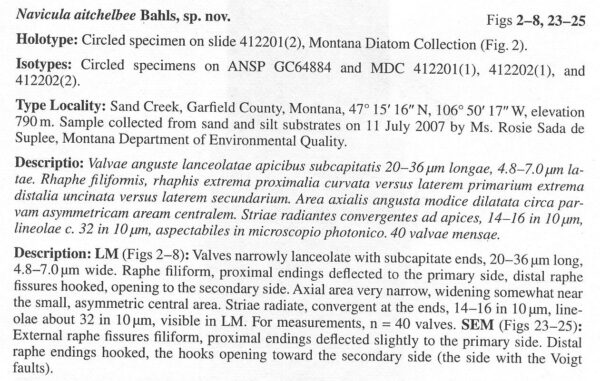Navicula aitchelbee
-
Category
-
Length Range20-36 µm
-
Width Range4.8-7.0 µm
-
Striae in 10 µm14-16
-
ContributorLoren Bahls - Mar 2012
-
ReviewerMark Edlund - May 2012
Identification
Description
Valves are narrowly lanceolate with subcapitate apices. Raphe branches are filiform with proximal endings deflected to the primary side. Distal raphe fissures are hooked to the secondary side. The axial area is very narrow and widens somewhat near the small, asymmetric central area. Striae are radiate and become convergent at the ends. Areolae number approximately 32 in 10 μm and are usually visible in LM.
Autecology
Navicula aitchelbee is widely distributed in soft-bottomed streams of the Northwestern Great Plains (eastern Montana and Wyoming, western North Dakota and South Dakota) where it may be locally abundant. In these streams the mean pH is 8.5 and the mean specific conductance is 3627 µS/cm. The most frequently co-occurring diatom associates of N. aitchelbee are also salt-loving, epipelic taxa: Nitzschia frustulum var. subsalina, Cylindrotheca gracilis, Entomoneis paludosa, Nitzschia nana, Synedra famelica, Navicula salinicola, Hippodonta hungarica, Ctenophora pulchella, Navicymbula pusilla, and Navicula eidrigiana.
-
Size Range, µm3
-
Motility
-
Attachment
-
Habitat
-
Colony
-
Waterbody
- Learn more about this
Original Description
Valves narrowly lanceolate with subcapitate ends, 20–36 μm long, 4.8–7.0 μm wide. Raphe filiform, proximal endings deflected to the primary side, distal raphe fissures hooked, opening to the secondary side. Axial area very narrow, widening somewhat near the small, asymmetric central area. Striae radiate, convergent at the ends, 14 –16 in 10 μm, lineolae about 32 in 10 μm, visible in LM. For measurements, n = 40 valves. SEM (Figs 23 – 25): External raphe fissures filiform, proximal endings deflected slightly to the primary side. Distal raphe endings hooked, the hooks opening toward the secondary side (the side with the Voigt faults).
-
AuthorBahls 2012
-
Length Range20-36 µm
-
Width4.8-7.0 µm
-
Striae in 10µm14-16
Cite This Page
Bahls, L. (2012). Navicula aitchelbee. In Diatoms of North America. Retrieved April 18, 2024, from https://diatoms.org/species/navicula_aitchelbee
Responses
The 15 response plots show an environmental variable (x axis) against the relative abundance (y axis) of Navicula aitchelbee from all the stream reaches where it was present. Note that the relative abundance scale is the same on each plot. Explanation of each environmental variable and units are as follows:
ELEVATION = stream reach elevation (meters)
STRAHLER = distribution plot of the Strahler Stream Order
SLOPE = stream reach gradient (degrees)
W1_HALL = an index that is a measure of streamside (riparian) human activity that ranges from 0 - 10, with a value of 0 indicating of minimal disturbance to a value of 10 indicating severe disturbance.
PHSTVL = pH measured in a sealed syringe sample (pH units)
log_COND = log concentration of specific conductivity (µS/cm)
log_PTL = log concentration of total phosphorus (µg/L)
log_NO3 = log concentration of nitrate (µeq/L)
log_DOC = log concentration of dissolved organic carbon (mg/L)
log_SIO2 = log concentration of silicon (mg/L)
log_NA = log concentration of sodium (µeq/L)
log_HCO3 = log concentration of the bicarbonate ion (µeq/L)
EMBED = percent of the stream substrate that is embedded by sand and fine sediment
log_TURBIDITY = log of turbidity, a measure of cloudiness of water, in nephelometric turbidity units (NTU).
DISTOT = an index of total human disturbance in the watershed that ranges from 1 - 100, with a value of 0 indicating of minimal disturbance to a value of 100 indicating severe disturbance.

Navicula aitchelbee
- Apices subcapitate
- Central area small, asymmetric
- Striae straight, 14-16 in 10 μm
Navicula aitchelbee has lanceolate valves 20-36 μm long with subcapitate apices. The central area is small and asymmetric. Striae number 14-16 in 10 μm and are straight near the central area.
 Diatoms of North America
Diatoms of North America





